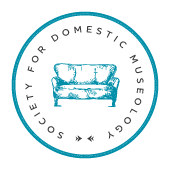After a longer than expected hiatus, we had the good fortune to open 2016 at the Society for Domestic Museology with a special guest: artist Kristine Bolhuis, whose work I have long admired. I first met Kristine when we were undergraduates at the University of Michigan and lived in the same co-op. In the intervening years, we lost touch, but thanks to the magic of social media, we reconnected some years ago and I have kept up with her career from afar. Working out of her home studio in Ann Arbor, Michigan, Kristine creates intricately constructed metal jewelry based on geometric patterns.
When she was invited to participate in the LOOT2016 show this spring at the Museum of Art & Design just down the street from us, we started to hatch a plan. Not only would she bring work she was exhibiting and selling at MAD, but she would bring some pieces from another series she has worked on over the years to install in our home.
The series, entitled Talking Through a Closed Window, consists of four complex and layered metal brooches, along with several "sketches" in metal, depicting the gestures of sign language. Kristine began this series a few years after her son, Kaes, was born with Treacher Collins syndrome, a rare condition that causes significant hearing loss. Before his first year, Kristine and her husband, John, had learned to sign with their son, and she was astounded at how much they could communicate through gesture alone at such a young age. The inspiration for the series came from a poignant moment when Kaes was older and playing in the yard and Kristine marveled at their ability to sign a conversation through the kitchen window. Looking through baby pictures, she was struck by how many of them included signs that indicated what he was communicating in each captured moment. She started experimenting with metalwork that depicted signs and gestures, ultimately using the photos to render her children’s tiny hands in metal.
The series is a departure for Kristine, whose art works more with form and function than with narrative. As a young child, she was always interested in how things were constructed. Later, after studying Art History at the University of Michigan, she pursued fine arts, first drawing and ceramics, before settling on metalwork, which she regards as a form of three-dimensional drawing. The solitary nature of working with metals and their limited color palate appealed to her — as did the closed loop of the materials: all shavings and scraps are collected and melted down for new work, leaving virtually no waste. She cites the early Modernists Charles and Ray Eames as inspirations, as well as the work of sculptor Harry Bertoia, who studied at Cranbrook Academy of Art, where she received her MFA. Indeed, you can see echoes of Bertoia's famous diamond chairrunning through Kristine's kinetic jewelry.
In contrast, the brooches are more solid and symbolic. Their creation was a way to channel the trauma of those early years of learning how to parent a child with differences. Now almost 12, Kaes is thriving. Thanks to hearing aids, they no longer need to communicate through signing, so this series has become a commemorative document of a time she is only now revisiting
On the left section of the wall, are several unfinished metal pieces that were made by transferring prints of Kristine's hands signing letters into metal silhouettes. And hanging in the window are a series of small pendants showing the various gestures of a child's hand, all taken from photographs of Kaes and his younger sister. To round out the installation for our opening, Kristine included several examples of her jewelry, with slender, delicate lines that served as a counterpoint to the more substantial work on the wall.
What strikes me most about this series is the contrast between my preconceptions of metalwork as dense, static, and unforgiving and the dynamism of Kristine’s work, which is all about gesture and movement. The pieces are mounted on a white paper backing, underscoring Kristine’s sense of the work as sketches in three dimensions. They hover off the paper, mounted on tiny wires and look poised to fly away.
For Kristine, the installation was a chance to reexamine this emotionally fraught work, and the domestic setting served to highlight its origins in the home as the place where love and communication between parent and child are forged. Our opening event was a chance to discuss these ideas and consider her work in this context, as well as to celebrate our food co-op past with a vegetarian spread, including hummus, the staple of our diet back then.
In the weeks since the opening, we’ve noticed how visitors to our home are drawn to the mysterious objects on the wall. Once they realize the objects are signs, the urge is there to decipher what they have to say. To me, they are a moving totems that represent the subtle and gestural ways we communicate those closest to us.











